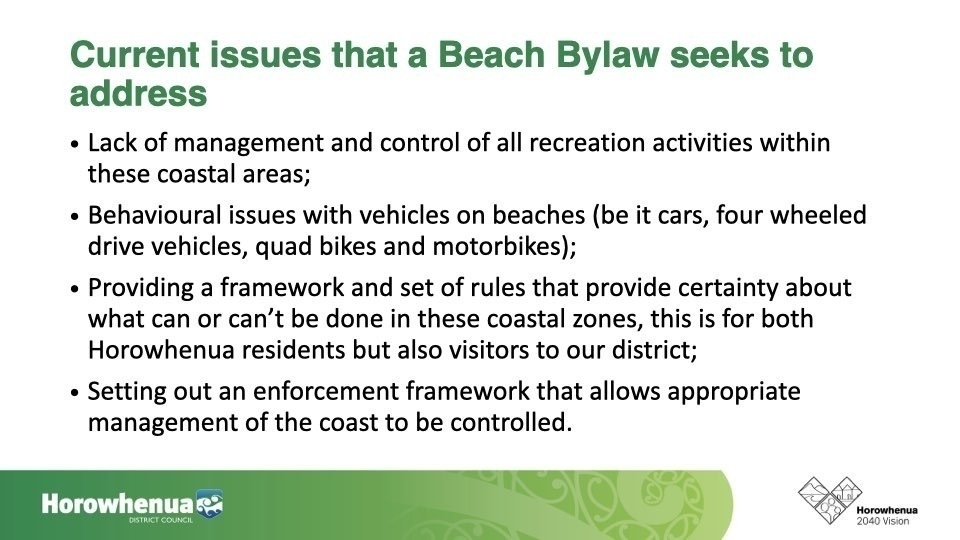
HDC Councillors recently rejected creating a new Beach Bylaw in favour of strengthening and enforcing current provisions. See Beach Bylaw Workshop November 2023 — report.
The problem is that most people who use vehicles at the beach (98% according to Cr. Brannigan) are careful and considerate but a few create havoc.
Below are the provisions already in place, but that need enforcing.
Current laws, Bylaws and Policies lay down expectations:
- no dumping waste (eg garden rubbish, other stuff)
- no disrupting the enjoyment of other beach visitors (eg with loud engine noise), endangering wildlife or other people or damaging plantings etc
- stick to the speed limit (30 Kph)
- drivers to be licensed, wear any required safety gear (eg motorbike helmets)
- vehicles to be licensed, registered, have relevant WoF, and display a number plate
- vehicles are to be only on the 'road' part of the beach (between the sea and the high tide line)
- no vehicles on dunes or tracks where vehicles are forbidden
The Police are the ones who enforce the law. It's worth reporting people who are creating havoc, preferably including photos or videos that can identify the vehicles.
Note: part of Waikawa Beach near the river mouth is privately owned Māori land that crosses the sand into the sea.
The Laws, Bylaws and Policies
The Land Transport Act 1998, Part 1, the Interpretation, says: “road includes— (c) a beach.”
The clearest statement I’ve seen of how beach is defined is “Beach means: that area of sand between high and low water level.” (thanks to the Ōtorohanga and also Waikato District Councils).
So: where vehicles may drive, according to law, is that area of sand close to the sea, not other areas such as in or near the dunes.
Horowhenua District Council has the authority to set the speed limit on that road. On 27 November 2017 the Council voted to set the maximum speed for vehicles on all of Horowhenua’s beaches to 30 Kph.

Road rules apply to the beach (road)
The beach is legally a road and so various provisions apply under the Land Transport Act 1998 and the Land Transport (Motor Vehicle Registration and Licensing) Regulations 2011. Headings include:
- 5: Drivers to be licensed
- 6: Vehicles to be safe and operated in compliance with rules
- 7: Drivers not to be reckless or dangerous
- 8: Drivers not to be careless or inconsiderate
- 77: Operation of unregistered or unlicensed motor vehicle

HDC Public Places Bylaw 2016
HDC Public Places Bylaw (PDF) applies to all public places including the beach, foreshore and dunes. The following extracts are specifically relevant to problem behaviours on the beach.
The purpose of this Bylaw is to:
- (a) protect the public from nuisance which may arise from activities undertaken in public places;
- (b) ensure public health and safety is maintained; and regulate and manage occupation and use of those public places for trading, entertainment and other activities for the well-being and enjoyment of the public.
The HDC interpretation of beach is wider than was specified above for the 'road':
Beach means the foreshore (including the inter-tidal zone above the mean low water spring) and any adjacent area that can reasonably be considered part of the beach environment including areas of sand, pebbles, shingle, dunes or coastal vegetation and includes the adjacent coastal marine area.
The Bylaw specifies what nuisance
means:
Nuisance has the same meaning as section 29 of the Health Act 1956 and without limiting that statutory meaning, includes a person, animal, thing or circumstance causing unreasonable interference with the peace, comfort and convenience of another person whether or not that person is in a public place.
Now we get to the nitty gritty of the Bylaw that covers the anti-social behaviours of using a vehicle to disrupt peaceful enjoyment through excessive noise, damaging dunes and other things like signs, posts or protective tape, and dumping rubbish on the beach.
6: Nuisances, Safety and Behaviour in Any Public Place
6.1: A person must not use a public place to:
- (a) wilfully obstruct, disturb or interfere with any other person in their use or enjoyment of that public place;
- (b) create a nuisance … from making any excessive sound or noise;
- (c) use any material or thing (including but not limited to a vehicle …) recklessly or in a manner which may intimidate, be dangerous, be injurious to or cause a nuisance to any person;
- (h) cause or allow material or thing or substance to be deposited or dropped on a public place.
6.2: A person must not cause or permit to be done any act whatsoever by which damage is caused to any public place, or to any work or thing in, on, over or under the public place, with the exception of drawing on the footpath with chalk.
These are the provisions that already exist, but can be better enforced to allow everyone to quietly enjoy the beach, whether it be for taking a boat or fishing gear down to the water, having a walk, heading down for a picnic or just looking at the view and listening to the sounds of nature.